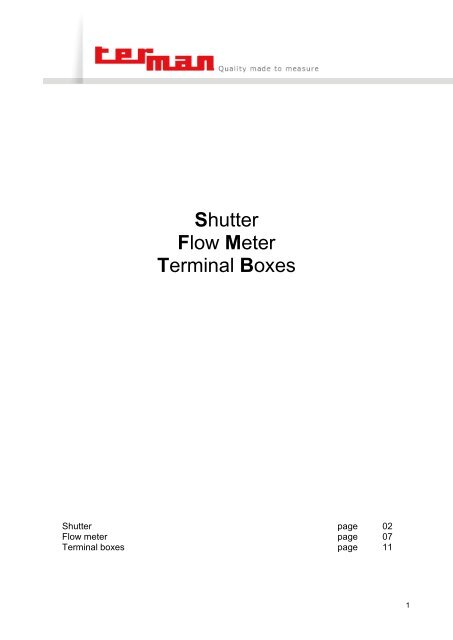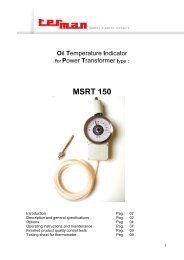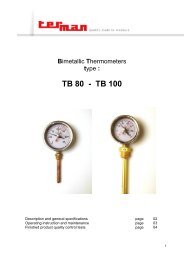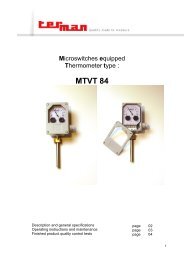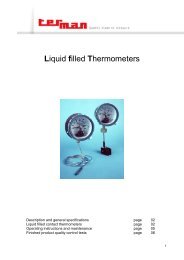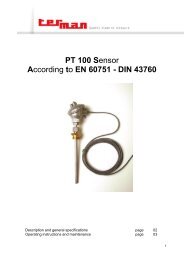Download - Shutter Flow Meter Terminal Boxes - TERMAN
Download - Shutter Flow Meter Terminal Boxes - TERMAN
Download - Shutter Flow Meter Terminal Boxes - TERMAN
You also want an ePaper? Increase the reach of your titles
YUMPU automatically turns print PDFs into web optimized ePapers that Google loves.
<strong>Shutter</strong><br />
<strong>Flow</strong> meter<br />
<strong>Terminal</strong> boxes<br />
<strong>Shutter</strong><br />
<strong>Flow</strong> <strong>Meter</strong><br />
<strong>Terminal</strong> <strong>Boxes</strong><br />
page<br />
page<br />
page<br />
02<br />
07<br />
11<br />
1
<strong>Shutter</strong> Valve<br />
DAROC<br />
Description and general specifications<br />
Production range and operating conditions<br />
Operation<br />
Installation, setting and putting in service<br />
page<br />
page<br />
page<br />
page<br />
03<br />
03<br />
04<br />
04<br />
2
Description and general specifications.<br />
Transformer conservators are usually arranged in such a way that, even at minimum level, the oil is always<br />
above the highest point of the transformer lid. When a leak occurs in the tank, due for example to a broken<br />
bushing, the oil in the conservator pours out, thus considerably increasing the danger of fire and pollution.<br />
The automatic conservator oil shutters DAROC Series DS and EDS-R have been designed to prevent the oil<br />
contained in the conservator from flowing out when a leak occurs and, for Series EDS-R, to signal this by an<br />
electric contact.<br />
Main features of the DAROC shutters Series DS and EDS-R are:<br />
ï They are mounted on the pipe from tank to conservator, in series with the Buchholz relay, so they can be<br />
used both on conservators with free oil surface and on conservators with rubber bag;<br />
ï The operation is completely automatic. When, due to a leakage in the tank, the oil flow rate from conservator<br />
to tank exceeds a set value, the DAROC valve closes the pipe thus preventing the loss of the conservator<br />
oil;<br />
ï Should the DAROC valve trip unduly, because of a malfunction or of particular working conditions, a pre-set<br />
by-pass valve operates automatically and prevents the internal depression in the tank from becoming excessive;<br />
ï The DAROC shutter has to be reset manually after tripping; if requested an additional by-pass pipe allows<br />
to reset the valve from ground level.<br />
The shutting-off of the pipe between tank and conservator is always an abnormal operating condition; it is<br />
therefore preferable to choose the DAROC Series EDS-R shutter in order to have a warning by electric contact<br />
that the valve has tripped.<br />
Production Range and Operating Conditions.<br />
DAROC Series DS and EDS-R shutters can be fitted to pipelines of nominal diameter 50, 80 or 100 mm; The<br />
valves can be equipped with one or two electric contacts and can operate under following conditions:<br />
ï Oil and ambient temperature range : -25 C to + 120 C (standard version)<br />
ï Oil features ( standard version ) : ◊ Mineral oil<br />
◊ Oil viscosity 30 cStk at 20 C<br />
Please note: with other oil viscosity the flow rates change according to the setting diagram<br />
ï Vibration resistance : 3 g on all axis<br />
ï Check resistance : 10 g on all axis<br />
ï Maximum operating pressure : 1,5 bars<br />
ï Maximum test pressure : 3 bars<br />
ï By-pass valve setting ñ standard version 0,4 bars<br />
ï Degree of protection : IP 65<br />
Casing : made of cast aluminium and has two flanges for mounting onto the pipeline which connects the<br />
tank to the conservator. One flange has threaded holes and a gasket groove so that the device can be fitted<br />
directly to the Buchholz relay. On casing two windows allow to visually check the operation of the device and<br />
two oil drain screws allow to empty the casing of oil if needed. The adjusting device and, if requested, the resetting<br />
by-pass pipe are also assembled on casing.<br />
The casing is closed by a cover which includes the terminal box for DAROC contacts equipped valves series<br />
EDS-R, a gas drain cock and the nameplate, which shows also the direction in which to mount the DAROC<br />
valve on the pipe, are attached to the head.<br />
3
Operation.<br />
During the operation of an electric transformer several conditions may occur which cause an oil flow in the<br />
pipe between tank and conservator:<br />
ï During the heating phase an oil flow from tank to conservator is observed, due to oil expansion as the<br />
transformer heats up; the flow rate is usually 30<br />
dm 3 /min.<br />
The first two conditions occur in normal service and should not cause the shutter Series DS and EDS-R<br />
valve to trip.<br />
The shutter is designed to trip automatically when the third condition occurs, thus stopping the oil<br />
flow from conservator to tank and preventing the oil in the conservator from being lost and slowing<br />
down the rate at which the oil seeps out at the leak.<br />
The shutter doesnít operate when the oil flows from tank to conservator; it trips when the oil flow from conservator<br />
to tank exceeds a set value.<br />
To operate correctly, the valve has to be set so that the admitted oil flow from conservator to tank is the<br />
maximum that will occur during the cooling phase. So, when a leak in the tank causes the oil flow to exceed<br />
the maximum set the valve will close and prevent the oil in the conservator from being lost.<br />
Damping System<br />
To take into account peaks of flow speed caused by accidental occurrences such as start up of pumps, elasticity<br />
of the tank or of the radiators, the closing of the main valve is retarded by a hydraulic damping system,<br />
which stops the valve from closing for flow speed peaks.<br />
After tripping due to an oil leak from the tank, the main valve has to be reset manually, either by the adjusting<br />
device or by the optional by-pass pipe.<br />
If the valve trips during the cooling phase, not withstanding the damping system described above, the valve<br />
will open again automatically during the heating phase, when the oil will start to flow from tank to conservator.<br />
Overpressure Valve Operation<br />
The main valve may close even in absence of a leak in the tank, for example when the oil in the pipe is very<br />
cold and therefore has a viscosity much higher than expected, or if the initial regulation has not been correctly<br />
done.<br />
In this case, the shrinking of the oil due to the cooling will cause an increasing negative pressure in the<br />
tank, while the cooling phase lasts. To limit the value of this negative pressure an overpressure valve has<br />
been built into the DAROC shutter.<br />
Installation, Setting and Putting in Service.<br />
Installation<br />
The DAROC shutter must be fitted onto the pipe between tank and conservator. The flange has a gasket<br />
groove and threaded holes in order to be able to fit it directly to the Buchholz relay. The gasket is supplied<br />
with the valve.<br />
If DAROC Series EDS-R is chosen, the electrical connection to the terminals has to be made according to<br />
the wiring diagram attached inside of the cover of terminal box.<br />
Setting<br />
The DAROC shutter is supplied set to the maximum stroke of main valve. In fact, when there is a leak in the<br />
tank, the flow rate is usually considerable higher than the flow rate admitted by the valve at full stroke with oil<br />
of normal viscosity.<br />
4
Taking into service<br />
After installation and setting it is possible to put the device in service by filling it up with oil.<br />
Maintenance<br />
The DAROC shutter doesnít need any particular maintenance; it is however advisable to check the correct<br />
operation regularly.<br />
Resetting of main Valve<br />
If the main valve closes accidentally during the cooling phase of the transformer, it may be necessary to reset<br />
it without having to wait for the heating phase. This can be done either by the forced opening screw or by<br />
the re-setting by-pass.<br />
Finish<br />
In standard version, all cast parts are protected by one coat of two-pack epoxy primer and one coat of twopack<br />
polyurethane paint, final colour RAL 7031 and screws and washer are of stainless steel; the degree of<br />
mechanical protection is IP 65. Therefore the device is suitable for outdoor usage even in tropical climate<br />
and with high industrial pollution. Special versions are available for particularly severe climatic and/or aggressive<br />
atmospheric conditions.<br />
Performances of contacts<br />
Magnetically operated, normally open, normally closed or changeover contacts.<br />
ï Contacts material : gold<br />
ï Operating temperature : - 50 C - + 125 C<br />
ï Breaking power : 150 W ñ 400 VA<br />
ï Insulation : 2000V 50Hz between terminals and earth for a 60 seconds time.<br />
ï Maximum current : 2 A<br />
ï Minimum and maximum tension : 24 ñ240 V<br />
ï Contact resistance : 500 mŸ<br />
5
<strong>Shutter</strong> ñ DAROC Type: EDS-R<br />
6
Oil <strong>Flow</strong> <strong>Meter</strong><br />
for Power Transformers type:<br />
Description and general specifications<br />
Operating instructions<br />
SCFR - 2<br />
page<br />
page<br />
08<br />
08<br />
7
Description and general specifications.<br />
Characteristics<br />
The circulation indicators Series SCFR2 ( Oil <strong>Flow</strong> Indicators) are designed to check the circulation of dielectric<br />
fluids, normally mineral oils, into the cooling plants of electric power transformers. It is possible to use<br />
said indicators with other kind of fluids too. Only it is necessary to use the right materials which are compatible<br />
with the circulating fluid.<br />
The circulation is optically indicated by an indicating pointer that shows on a dial if the oil is circulating or not.<br />
The optical indication may be not proportional to the flow velocity.<br />
The indicator can be equipped with one or two contacts that operate alarms in case the flow speed inside of<br />
the pipeline is lower than a minimum acceptable value.<br />
The operation of the indicator Series SCFR2 is based on the dynamic thrust of the flowing oil on a detection<br />
paddle placed inside of the pipe; the dimensions of the paddle depend from the diameter of the pipe. An adjustment<br />
device allows the triggering point to be modified within certain limits, also after the indicator mounting<br />
on the pipeline, in order to adapt it to the real flow conditions.<br />
Field of use<br />
The circulation indicators Series SCFR2 may be used with the following characteristic values:<br />
ï pipeline diameter : from 80 to 400 mm<br />
ï flow speed : from 0,5 to 3,0 m/sec<br />
ï fluid : mineral oil<br />
ï pressure inside of the pipeline : from 0,0 to 5,0 bar<br />
ï working temperature from : - 20 C to + 120 C<br />
ï resistance to vibrations : up to 3g on all axes<br />
ï resistance to shock : up to 10g on all axes<br />
Special features<br />
Basing to the experience of the previous series, special features have been included in the design of the circulation<br />
indicators Series SCFR2, with the aim of simplifying the choice of the device, granting easy interchangeability<br />
and allowing the user to adapt the operating characteristics to the actual needs.<br />
ï The big dial diameter and the bright colors of the figures and of the pointer consent easy reading from distance<br />
too.<br />
ï The construction si made in two separable parts: mounting flange, with detection paddle and adjustment<br />
system, and indicator case with optical indication and alarm contacts. This construction allows the indicator<br />
case removing for repairing or substitution or during the shipment of the transformer.<br />
ï the transmission of the paddle movement is made by means of a magnetic transmission thus granting a<br />
complete seal.<br />
ï the adjustment system is simple and reliable; the adjustment can be made even after the device has been<br />
mounted on the pipeline.<br />
Operation instructions.<br />
Construction features, finish and accessories<br />
Case : aluminium alloy. Gray color painted<br />
In standard execution, all cast parts are protected by one coat of two-pack epoxy primer and one coat of twopack<br />
polyurethane paint, final colour RAL 7031. Screws and washer are in stainless steel<br />
Closing ring : aluminium. Gray color painted<br />
Lens : tempered glass<br />
Paddle : brass<br />
Degree of mechanical protection : case=IP 55 contacts =IP 67<br />
Therefore the device is suitable for outdoor mounting even in tropical climate and with high industrial pollution.<br />
Special versions are available for particularly severe climatic and/or aggressive atmospheric conditions.<br />
8
The device is supplied with its assembly gasket. A cable gland is supplied on request.<br />
Wiring diagrams and contact performance<br />
As mentioned above, the circulation indicators Series SCFR2 can be supplied with one or two electric<br />
contacts.<br />
Contacts Performances : 5A 250 VAC<br />
0,25A 250 VDC<br />
0,5A 125 VDC<br />
Special contacts for electronic circuits having low current (1 to 100 mA) and voltage (4 to 10 V) can also be<br />
supplied.<br />
Operation<br />
The circulation indicators Series SCFR2 operate as follows:<br />
ï the oil flowing in the pipeline hits the detection paddle, thus causing the shaft on which it is mounted to<br />
rotate by about 90 against the force of the return spring;<br />
ï the dimension of the paddle is chosen according to the diameter of the pipe and the oil flow that it should<br />
detect;<br />
ï the tension in the return spring is pre-set at the manufacturing workshop in the middle of the adjustment<br />
range set; the set point may however be further adjusted by turning the adjustment assembly after removing<br />
the fixing screws; this adjustment can be made with the flange mounted on the pipe;<br />
ï the magnetic joint transmits the rotation of the paddle to the indicating pointer and operates at the same<br />
time the switches.<br />
Mounting, adjustment and maintenance<br />
Mounting<br />
The device is mounted on a flanged stub pipe, welded directly to the pipeline; the dimensions of the stub<br />
pipe should be as indicated in drawing N 12.600.10.<br />
To mount the device on the pipeline, separate the indicator head from the flange by removing the lateral<br />
screw and rotating the instrument by about 10 anticlockwise so as to free the screws from their holes; then<br />
attach the flange to the pipe by screws M8, with the assembly gasket in groove.<br />
After having attached the flange to the pipe, assemble the instrument's head on to the flange again<br />
and check that the optical display is operating correctly by starting up and stopping the circulation pump.<br />
If it is correctly working, make the cable layout according to the desired wiring diagram.<br />
If the optical or electrical indications are not correct, carry out the adjustment described later.<br />
In order to make sure the signal paddle is hit by the most uniform possible flow, avoid mounting the device<br />
immediately downstream of bends, necks or other parts which could cause turbulence in the flow.<br />
If this is impossible, the adjustment of the tension in the return spring, allows the indicator to be adapted to<br />
the real flow conditions.<br />
Adjustment<br />
The device is always supplied with the adjustment assembly set to position 3, so that it is possible to both<br />
increase and decrease the load of the return spring in order to set the device at a higher or lower flow rate.<br />
If the factory setting is not satisfactory adjust the setting as follows:<br />
ï remove the indicator head from flange as described above in order to get to the adjustment assembly<br />
fixed on the flange by four screws.<br />
ï remove the four screws; even if there is pressure in the pipe the adjustment assembly cannot come off the<br />
flange; furthermore a gasket continues to guarantee the seal;<br />
ï turn the adjustment block until the notch corresponds with one of the numbers on the flange, anticlockwise<br />
to increase the force of the spring and trigger the device at a higher flow rate, and clockwise to have the opposite<br />
effect;<br />
ï replace the 4 screws and re-assembly the indicator's head on the flange; then check that the adjustment<br />
made has the desired effect otherwise make a further adjustment.<br />
Maintenance<br />
9
The circulation indicators Series SCFR2 do not need periodic maintenance; however it is advisable to<br />
check regularly that they are operating correctly by starting up and stopping the circulation pump and<br />
checking that the optical and electrical display takes place as normal.<br />
Order specifications<br />
When ordering it is necessary to indicate the type of device according to the table in drawing N<br />
12.600.10, the diameter of the pipeline, the mounting position and the required wiring diagram. Standard cable<br />
entry thread is æ.; should another thread be preferred and a cable gland be needed, this has to be mentioned<br />
in order.<br />
10
<strong>Terminal</strong> <strong>Boxes</strong> Series<br />
Description and general specifications<br />
Operating conditions<br />
Quality control tests<br />
SM2<br />
page<br />
page<br />
page<br />
12<br />
12<br />
13<br />
11
Description and general specifications.<br />
This specification concerns the function, the main features, the range of types, the assembly and operation<br />
of the terminal boxes Series SM2. Environmental and operating conditions depend generally from the compatibility<br />
of the materials and components and from the surface treatment.<br />
Function<br />
The measurement, control, check and data recording circuits for medium and high power, oilcooled,<br />
oil-insulated electric transformers require medium and low voltage and current signals to be brought outside<br />
of the tank.<br />
The terminal boxes Series SM2 are designed and constructed to face this need since they offer oil-tight conductors<br />
protected with a flanged casing and accessible through cable entries.<br />
Construction features<br />
The terminal boxes Series SM2 consist mainly of a flanged casing, closed by a cover, inside which are<br />
mounted the terminals. One end of the terminal is wired inside of the transformer tank while the other end is<br />
wired outside the tank through threaded cable entries.<br />
The following data apply only to the terminal boxes Series SM2 fitted with M6 terminals.<br />
General specifications<br />
ï Flanged casing with lowered bottom to prevent air pockets; the casing has one or more cable entries and it<br />
is closed by a cover; the mechanical protection degree is IP 65; identification labels inside and outside of the<br />
box allow identification of terminal box as well as of terminals;<br />
ï The cable entries are threaded to customer request and supplied on request either plugged by brass plugs<br />
or with brass cable glands with gasket;<br />
ï <strong>Terminal</strong> boxes are supplied with the number of terminals requested by customer;<br />
ï The standard terminal is one-piece conductor threaded M6 at both ends for connection of a ÿ 6 mm cable<br />
terminal; oil-tightness is obtained by O-Ring gasket;<br />
ï The terminals are designed and mounted so that they cannot twist when the cable terminal is screwed on<br />
and have a Snap-On ring to prevent accidental loosening during transport, handling and mounting; they are<br />
evenly spaced so that they can be connected by connecting plates supplied on request;<br />
ï The terminals are supplied with copper washers; inside of the tank self-locking nuts are used to assure secure,<br />
vibration-proof wiring while the connection inside of the terminal box is assured with nut and counternut;<br />
ï <strong>Terminal</strong>s are numbered on both sides to ease cabling and allow identification;<br />
ï Special M10 terminals are also available.<br />
Materials and finish<br />
ï Casing and cover of aluminium casting, painted with one coat of epoxy primer and one finishing coat of<br />
polyurethane paint, colour RAL 7031; the epoxy primer is compatible with mineral transformer oil at a temperature<br />
of up to 120 C, the paint passes the 500 hour salt fog test;<br />
ï Nylon insulated nickel plated brass terminals with copper washers and vibration-proof nuts;<br />
ï <strong>Terminal</strong> gaskets of fluor silicone rubber;<br />
ï External screws and washers of stainless steel;<br />
ï Cable entries are closed by plastic plug during shipment.<br />
Operating conditions.<br />
ï Environmental temperature with standard gaskets - 20 C to + 50 C<br />
ï Relative humidity 95% at 20 C; 80% at 40 C; 50% at 50 C<br />
ï Protection degree of box IP 65<br />
ï Operating temperature (mineral oil) -20 C to +110 C<br />
ï Insulation to earth of terminal at 20 C > 5.000 V<br />
ï Standard M6 terminal cross section 12 mm2<br />
Special versions can be supplied for other environmental conditions<br />
12
Quality control tests.<br />
Following tests and controls are performed on boxes before despatch :<br />
ï Insulation test of terminals towards box; test voltage 3.000V;<br />
ï Tightness test of mounted terminals by compressed air and immersion in water bath; test<br />
pressure 1 bar;<br />
ï Control of correct numbering of terminals.<br />
Range of types<br />
The terminal boxes Series SM2 are produced in 4 types as follows :<br />
ï Type SM2-X<br />
◊ Dimensions to drawing N 15.112.00<br />
◊ Number of terminals from 2 to 6<br />
◊ Number and dimensions of cable entries 1 to 2 - max æî or PG 21or ÿ 35 mm<br />
ï Type SM2-S<br />
◊ Dimensions to drawing N 15.102.00<br />
◊ Number of terminals from 2 to 12<br />
◊ Number and dimensions of cable entries 1 to 3 - max 1î or PG 29 or ÿ 40 mm<br />
ï Type SM2-L<br />
◊ Dimensions to drawing N 15.136.00<br />
◊ Number of terminals from 2 to 36<br />
◊ Number and dimensions of cable entries 1 to 3 - max 1î or PG 29 or ÿ 40 mm<br />
ï Type SM2-XL<br />
◊ Dimensions to drawing N 15.236.00<br />
◊ Number of terminals from 2 to 47<br />
◊ Number and dimensions of cable entries 1 to 4 - max 11/2î or PG 42 or ÿ 50 mm<br />
Drawings showing the construction of the terminals:<br />
ï <strong>Terminal</strong> M6 N 15.102.001<br />
ï <strong>Terminal</strong> M10 N 15.102.002<br />
Assembly and operation<br />
It is advisable to prepare a wiring diagram for each terminal box before assembling, showing the identification<br />
of the terminal box, which can be engraved on the terminal box identification plate, and the correspondence<br />
between the wire identification and the number of the terminal.<br />
<strong>Terminal</strong> boxes Series SM2 are then mounted on the transformer tank as follows :<br />
ï the wires inside of the tank are first connected to the terminals on the bottom of the terminal box in accordance<br />
with the wiring diagram; for easy wiring and record it is advised to write the wire identification number<br />
on the identification plate inside of the terminal box cover in correspondence to the number identifying the<br />
terminal;<br />
ï the terminal box is then bolted to the tank; the flange O-Ring gasket assures oil-tightness;<br />
ï the external wires are then led inside of the terminal box through the cable entries, there to be connected to<br />
the external part of the terminals; each wire has to be connected to the terminal following the numbering previously<br />
set up;<br />
ï if necessary one or more terminals can be connected by conducting plates that can be supplied separately;<br />
ï when the wiring is finished close the cover of the terminal box.<br />
13
TERMINAL BOX SM2-X<br />
14
TERMINAL BOX SM2-S<br />
15
TERMINAL BOX SM2-L<br />
16
TERMINAL BOX SM2-XL<br />
17
Terman '90 S.r.l., Via Ghisalba, 13-20/21, 20021 Bollate (MI) ñ Italy. Tel: +39 02 38 30 37 12, Fax: +39 02 38 30 37 19, E-<br />
Mail info@terman.com, www.terman.com<br />
C.F./P. IVA IT 09970270154 ñ C.C.I.A.A. 1332904 ñ Trib. Milano Reg. Soc. 302729 ñ Cap. Soc. Ä 119.000<br />
20


